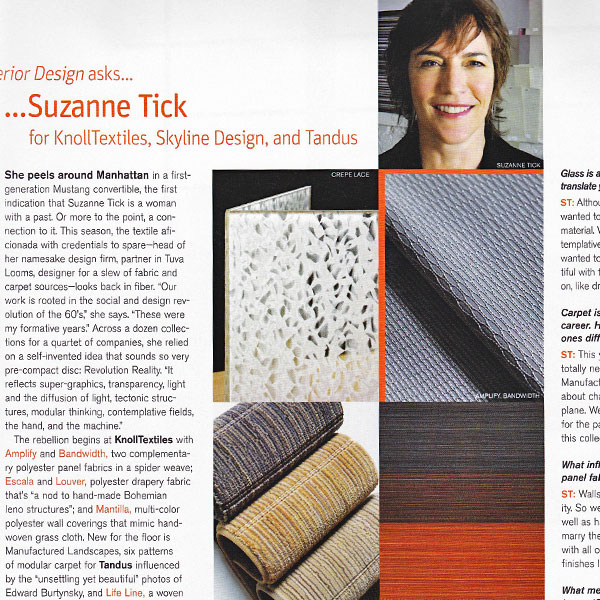Source: NeoCon Show Daily 2008
She peels around Manhattan in a first-generation Mustang convertible, the first indication that Suzanne Tick is a woman with a past. Or more to the point, a connection to it. This season, the textile aficionada with credentials to spare—head of her namesake design firm, partner in Tuva Looms, designer for a slew of fabric and carpet sources—looks back in fiber. "Our work is rooted in the social and design revolution of the 60's," she says. "These were my formative years." Across a dozen collections for a quartet of companies, she relied on a self-invented idea that sounds so very pre-compact disc: Revolution Reality. "It reflects super-graphics, transparency, light and the diffusion of light, tectonic structures, modular thinking, contemplative fields, the hand, and the machine."
The rebellion begins at KnollTextiles with Amplify and Bandwidth, two complementary polyester panel fabrics in a spider weave; Escala and Louver, polyester drapery fabric that's a nod to handmade Bohemian leno structures; Mantilla, multicolor polyester wallcoverings that mimic handwoven grass cloth. New for the floor is Manufactured Landscapes, six patterns of modular carpet for Tandus influenced by the "unsettling yet beautiful" photos of Edward Burtynsky, and Life Line, a woven velvet, cut-loop broadloom construction for Tuva Looms meant to resemble variegated zebra wood. Tick's intriguing collaboration this spring is with decorative glass supplier Skyline Design, for whom she has translated her signature weaves into 10 etched-glass patterns.
How do you stay inspired and focused when working on a variety of collections for different manufacturers?
ST: All of our work is rooted in structure, new technologies, and processes. The basic tenets on weaving always inform, whether it's carpet, textiles, or glass.
Glass is a new area for you. How did you translate your signature work in this medium?
ST: Although glass was a departure, we wanted to look at glass as a tactile and fluid material. We thought of transparency, contemplative fields, and the filtering of light. I wanted to create glass that would look beautiful with the other substrates that we work on, like drapery, wallcovering, and carpet.
Carpet is obviously a huge part of your career. How was working on these latest ones different than in previous years?
ST: This year we will be debuting a totally new concept for carpet tile called Manufactured Landscapes. It's a dialogue about changing the dynamic of the floor plane. We have been exploring carpet tile for the past two years and really feel that this collection is a true breakthrough.
What influenced your design for new panel fabrics for KnollTextiles?
ST: Walls today have to have a tactile quality. So we reviewed tectonic structures as well as handwoven looks, and worked to marry them. We colored the line to work with all of KnollTextiles and today's interior finishes like stone, glass, and wood.
What medium do you think you'd like to try next?
ST: We continue to be enamored with our textile work and their presence in interiors. We love what we do and feel that if we stay pure with our work, new opportunities will find us. Lately we have been very inspired by reused materials and rapid prototyping.
